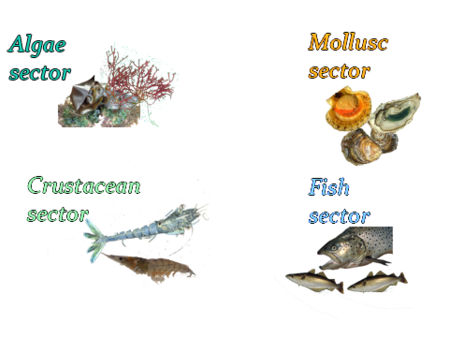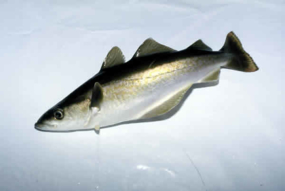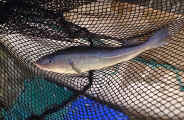Gadids
Name : | Pollack | Cod |
|---|---|---|
Scientific name : | Pollachius pollachius (Linné, 1758), pollack – Gadidae family, originating from the Atlantic, from the Portugal to the north of Norway. | Gadus morhua (Linné, 1758), cod or fresh cod (sold fresh), Gadidae family, originating from the north Atlantic, bust also found in the Baltic sea and in the Barents sea. |
Size : | maximum length: 1.30 m, maximum weight: 18 kg, life expectancy 8 years | maximum size: 1.8 - 2 m ; weight: 15 kg at 7 years (Celtic sea stock) |
Pollack - history, rearing techniques and production cycle
Pollack aquaculture has only started recently in two European sites: in France (Brittany, 1995) and in Spain (Galicia), within the framework of the diversification of the marine species aquaculture. This industry is not yet developed.
The pollack reaches sexual maturity at the age of 2 for the males (0.7 kg) and 3 for the females (1.6 kg). The best quality egg-laying (January to May) are obtained at temperatures of 8 to 10°C. A female lays about 600,000 eggs per kilo (size 1.3 mm). Eggs develop for about 7 days at 10°C. The hatched larvae (size 3.5 mm) exhibit the yellow chromatophores specific to the species.
Following a feeding process that comprises rotifers and then small crustaceans (Artemia), metamorphosis and the best survival rate are reached after 1 month at 12-15°C. Probiotics help the growth. In juveniles, the maximum growth is achieved using dry feed (proteins/lipids: 50/12), at a temperature comprised between 12 and 18°C. Inside ponds, fish reach a mean weight of 340 to 400 g within 18 months after hatching. Inside cages, at a temperature between 9 and 17°C, the pollack reaches a weight of 630 g in 2 years and of 1.5 kilo in 3 years; beyond a temperature of 21-22°C, the food intake drops.
Cod - history, rearing techniques and production cycle
Cod aquaculture started with captivity farming more than 100 years ago in Norway and in Canada. Until the seventies, the objective was to produce alevins to replenish local wild populations, and the farming industry only started about 15 years ago. Captive fattening up to commercial size was developed in Europe (Scotland, Norway and Iceland), in Canada, and in the USA (Maine). Cod farming is only beginning in France.
The two-year farming cycle is comparable to that of salmon. The cod matures – depending on the location – from January to March, yet the production of eggs and larvae can take place all year round. A captive female of 3.5 kg can lay between 3 and 5 million eggs (1.3 – 1.5 mm). The eggs hatch after a period of 10 to 14 days at a temperature of 6 to 8°C. The larvae (4 – 4.5 mm) feed on their yolk bag for about a week, then on live preys (plankton), or artificial food (micro-particles).
Cannibalism – frequent in this species – is minimized thanks to sufficient continuous feeding and to the sorting of the alevins to homogenize the sizes. Farming is carried out in water reservoirs or inland ponds. Within a few months, the fish reach a weight of 100 g, then 800 g after 1 year and 2 kg after 2 years.
The optimal growth temperature is about 12 to 15°C, and a good performance is achieved with a lipid content in the feed ranging from 12 to 16 %. This species can accept densities of up to 40 kg/m3
In France, trials conducted on cods captured in the North Sea or in the Channel have given rise to a better survival rate for the second group, maturation in captivity for all the females regardless of their origin as soon as they reach 2 kg, high quality egg laying, and a good survival rate in the early phases.
Pollack and cod yields evolution
Cod aquaculture has grown slowly in Nordic countries, whilst benefiting from the farming technical nature of salmonidae (cage fattening), and of other marine species (hatcheries). The production of cod from aquaculture is increasing; it reached nearly 21,381 tons in 2008, provided mainly by Norway (84.5%).
In France the first experiments initiated for the two species, stopped. Spain continues development of pollack production with regularity.
Product value enhancement : pollack and cod
These lean fish are highly appreciated in Europe. In France, half of the imported tonnage of fresh cod concerns whole fresh fish, the other half being composed of frozen fillets and dried/salted cod. Demand is mainly for fillets and whole fish (2 to 5 kg) for steaks. Moreover, salted cod is used in transformed products, frozen portions, precooked meals and other less known forms such as smoked liver. The demand for those species and other "white fish" is continuously increasing.
Some key figures of Gadidae (tons, data in 2009, FranceAgrimer)
121 712 | The apparent French cod consumption with 98% imported |
|---|---|
1 % | The part of French consumption of pollack (in tons) is provided by fish-farming |
Strengths / Weaknesses
Strengths | Weaknesses |
|---|---|
Concerning the two species | |
|
|
Pollack | |
|
|
Cod | |
|
|



